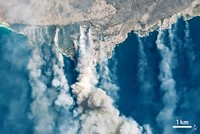Advertisement
Grab your lab coat. Let's get started
Welcome!
Welcome!
Create an account below to get 6 C&EN articles per month, receive newsletters and more - all free.
It seems this is your first time logging in online. Please enter the following information to continue.
As an ACS member you automatically get access to this site. All we need is few more details to create your reading experience.
Not you? Sign in with a different account.
Not you? Sign in with a different account.
ERROR 1
ERROR 1
ERROR 2
ERROR 2
ERROR 2
ERROR 2
ERROR 2
Password and Confirm password must match.
If you have an ACS member number, please enter it here so we can link this account to your membership. (optional)
ERROR 2
ACS values your privacy. By submitting your information, you are gaining access to C&EN and subscribing to our weekly newsletter. We use the information you provide to make your reading experience better, and we will never sell your data to third party members.
Atmospheric Chemistry
Iron From Antarctic Rocks Fuels Algae Growth
Ocean Chemistry: The iron source may drive some of the Southern Ocean’s huge carbon uptake
by Mark Schrope
May 28, 2013

Phytoplankton in the Southern Ocean pull down a large amount of carbon dioxide from the atmosphere. Oceanographers have wondered where these photosynthetic microbes get enough iron to fuel this process. A new study suggests that iron leached into the sea from rock weathering and bacterial activity on Antarctica may be part of the answer (Environ. Sci. Technol. 2013, DOI: 10.1021/es305141b). Climate change could actually accelerate this iron release, leading to larger blooms of phytoplankton and more carbon dioxide uptake by the ocean, the researchers say.
Though the Southern Ocean around Antarctica encompasses only about a quarter of the global ocean, algae there take up roughly 40% of all the carbon dioxide that the planet’s seas absorb. Previous studies have shown that the level of phytoplankton growth in the Southern Ocean, and as a result how much carbon dioxide the sea can absorb, depends on the amount of iron in the water. But researchers have had a difficult time accounting for how enough iron enters that sea to fuel its high level of algal growth.
A group of Spanish and Chilean researchers led by Bernhard Dold, a geochemist at Chile’s University of Concepción, set out to estimate how much iron might be liberated from Antarctic rocks. They considered two key processes. Weathering caused by wind and water breaks down rocks chemically, forming iron oxides. Also, through a process called acid rock drainage, bacteria oxidize iron-containing minerals such as pyrite, transforming the iron into a soluble form. Both processes free iron that can then wash into the ocean, either through runoff or groundwater.
The team went on three expeditions to Antarctica to collect water, rock, and microbe samples. Their second trip got cut short as they had to retreat to their icebreaker ship via helicopter to dodge an approaching storm. But before leaving, they observed that schwertmannite, an iron-rich mineral produced through acid rock drainage, had turned much of the ice in the protected cove where they were working reddish brown. The storm ultimately pushed the schwertmannite ice out to sea, a potential mechanism along with ocean currents for transporting iron away from land, the researchers say.
The team found that phytoplankton blooms coincided with times when the iron transport was likely to be greatest, suggesting a linkage between iron from the continent and algal growth. Overall, the researchers estimate that rock weathering releases some 450 million g of iron per year into the sea, and acid rock drainage another 1 billion g of dissolved iron. These estimates put the rocks on par with other major iron sources. For example, dust blown from other continents deposits about 1 billion g of iron into the Southern Ocean each year.
“This is one more piece of the puzzle,” says Kenneth S. Johnson, an ocean chemist at the Monterey Bay Aquarium Research Institute in Moss Landing, Calif. “The whole Southern Ocean is just starved for iron, so any kind of source is possibly significant.”
The researchers say that as global temperatures increase and Antarctic ice melts, the magnitude of these iron releases likely will grow, because weathering and acid rock drainage expand as temperatures and rock exposure increase. This could mean a welcome, if small, mitigating effect to climate change by accelerating phytoplankton growth and carbon dioxide uptake in the Southern Ocean.



Join the conversation
Contact the reporter
Submit a Letter to the Editor for publication
Engage with us on Twitter